Gabriele Picco
Description Boosting for Zero-Shot Entity and Relation Classification
Jun 04, 2024

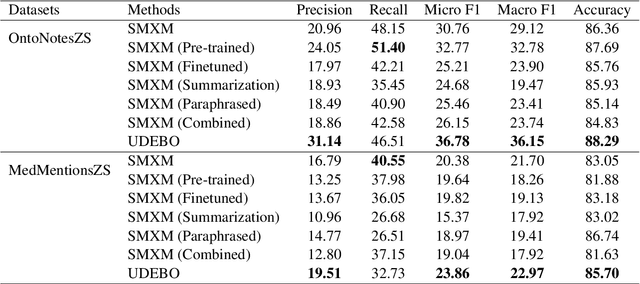
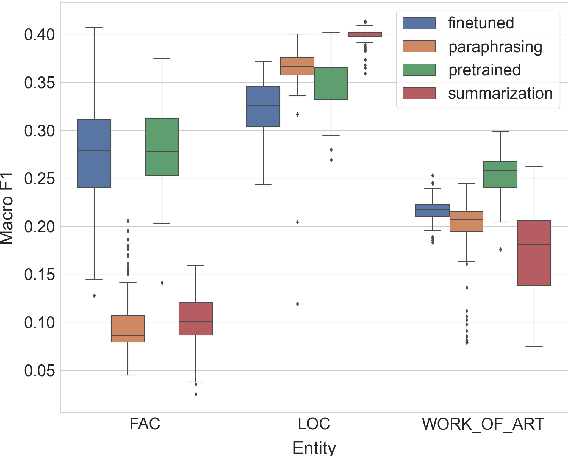
Abstract:Zero-shot entity and relation classification models leverage available external information of unseen classes -- e.g., textual descriptions -- to annotate input text data. Thanks to the minimum data requirement, Zero-Shot Learning (ZSL) methods have high value in practice, especially in applications where labeled data is scarce. Even though recent research in ZSL has demonstrated significant results, our analysis reveals that those methods are sensitive to provided textual descriptions of entities (or relations). Even a minor modification of descriptions can lead to a change in the decision boundary between entity (or relation) classes. In this paper, we formally define the problem of identifying effective descriptions for zero shot inference. We propose a strategy for generating variations of an initial description, a heuristic for ranking them and an ensemble method capable of boosting the predictions of zero-shot models through description enhancement. Empirical results on four different entity and relation classification datasets show that our proposed method outperform existing approaches and achieve new SOTA results on these datasets under the ZSL settings. The source code of the proposed solutions and the evaluation framework are open-sourced.
Zshot: An Open-source Framework for Zero-Shot Named Entity Recognition and Relation Extraction
Jul 25, 2023Abstract:The Zero-Shot Learning (ZSL) task pertains to the identification of entities or relations in texts that were not seen during training. ZSL has emerged as a critical research area due to the scarcity of labeled data in specific domains, and its applications have grown significantly in recent years. With the advent of large pretrained language models, several novel methods have been proposed, resulting in substantial improvements in ZSL performance. There is a growing demand, both in the research community and industry, for a comprehensive ZSL framework that facilitates the development and accessibility of the latest methods and pretrained models.In this study, we propose a novel ZSL framework called Zshot that aims to address the aforementioned challenges. Our primary objective is to provide a platform that allows researchers to compare different state-of-the-art ZSL methods with standard benchmark datasets. Additionally, we have designed our framework to support the industry with readily available APIs for production under the standard SpaCy NLP pipeline. Our API is extendible and evaluable, moreover, we include numerous enhancements such as boosting the accuracy with pipeline ensembling and visualization utilities available as a SpaCy extension.
* Accepted at ACL 2023
Otter-Knowledge: benchmarks of multimodal knowledge graph representation learning from different sources for drug discovery
Jun 23, 2023Abstract:Recent research in representation learning utilizes large databases of proteins or molecules to acquire knowledge of drug and protein structures through unsupervised learning techniques. These pre-trained representations have proven to significantly enhance the accuracy of subsequent tasks, such as predicting the affinity between drugs and target proteins. In this study, we demonstrate that by incorporating knowledge graphs from diverse sources and modalities into the sequences or SMILES representation, we can further enrich the representation and achieve state-of-the-art results on established benchmark datasets. We provide preprocessed and integrated data obtained from 7 public sources, which encompass over 30M triples. Additionally, we make available the pre-trained models based on this data, along with the reported outcomes of their performance on three widely-used benchmark datasets for drug-target binding affinity prediction found in the Therapeutic Data Commons (TDC) benchmarks. Additionally, we make the source code for training models on benchmark datasets publicly available. Our objective in releasing these pre-trained models, accompanied by clean data for model pretraining and benchmark results, is to encourage research in knowledge-enhanced representation learning.
Matching Pairs: Attributing Fine-Tuned Models to their Pre-Trained Large Language Models
Jun 15, 2023Abstract:The wide applicability and adaptability of generative large language models (LLMs) has enabled their rapid adoption. While the pre-trained models can perform many tasks, such models are often fine-tuned to improve their performance on various downstream applications. However, this leads to issues over violation of model licenses, model theft, and copyright infringement. Moreover, recent advances show that generative technology is capable of producing harmful content which exacerbates the problems of accountability within model supply chains. Thus, we need a method to investigate how a model was trained or a piece of text was generated and what their pre-trained base model was. In this paper we take the first step to address this open problem by tracing back the origin of a given fine-tuned LLM to its corresponding pre-trained base model. We consider different knowledge levels and attribution strategies, and find that we can correctly trace back 8 out of the 10 fine tuned models with our best method.
Ensembling Graph Predictions for AMR Parsing
Oct 18, 2021
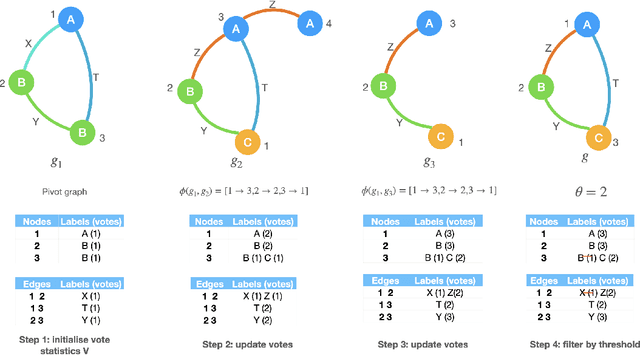
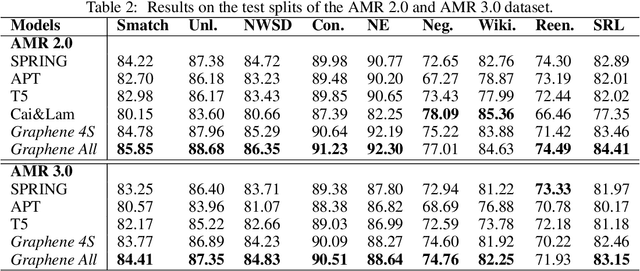
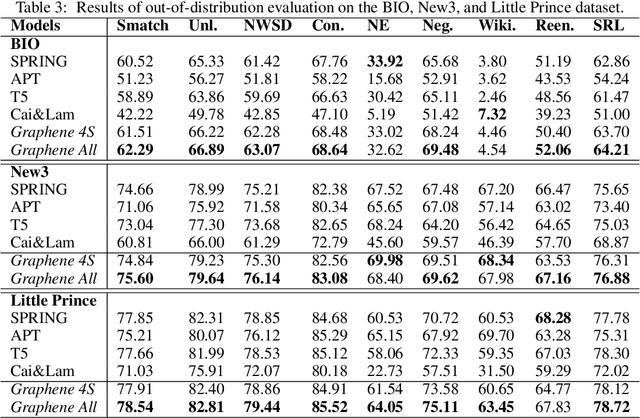
Abstract:In many machine learning tasks, models are trained to predict structure data such as graphs. For example, in natural language processing, it is very common to parse texts into dependency trees or abstract meaning representation (AMR) graphs. On the other hand, ensemble methods combine predictions from multiple models to create a new one that is more robust and accurate than individual predictions. In the literature, there are many ensembling techniques proposed for classification or regression problems, however, ensemble graph prediction has not been studied thoroughly. In this work, we formalize this problem as mining the largest graph that is the most supported by a collection of graph predictions. As the problem is NP-Hard, we propose an efficient heuristic algorithm to approximate the optimal solution. To validate our approach, we carried out experiments in AMR parsing problems. The experimental results demonstrate that the proposed approach can combine the strength of state-of-the-art AMR parsers to create new predictions that are more accurate than any individual models in five standard benchmark datasets.
Neural Unification for Logic Reasoning over Natural Language
Sep 17, 2021
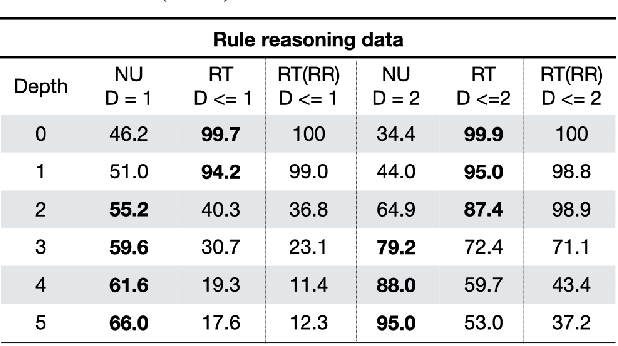


Abstract:Automated Theorem Proving (ATP) deals with the development of computer programs being able to show that some conjectures (queries) are a logical consequence of a set of axioms (facts and rules). There exists several successful ATPs where conjectures and axioms are formally provided (e.g. formalised as First Order Logic formulas). Recent approaches, such as (Clark et al., 2020), have proposed transformer-based architectures for deriving conjectures given axioms expressed in natural language (English). The conjecture is verified through a binary text classifier, where the transformers model is trained to predict the truth value of a conjecture given the axioms. The RuleTaker approach of (Clark et al., 2020) achieves appealing results both in terms of accuracy and in the ability to generalize, showing that when the model is trained with deep enough queries (at least 3 inference steps), the transformers are able to correctly answer the majority of queries (97.6%) that require up to 5 inference steps. In this work we propose a new architecture, namely the Neural Unifier, and a relative training procedure, which achieves state-of-the-art results in term of generalisation, showing that mimicking a well-known inference procedure, the backward chaining, it is possible to answer deep queries even when the model is trained only on shallow ones. The approach is demonstrated in experiments using a diverse set of benchmark data.
 Add to Chrome
Add to Chrome Add to Firefox
Add to Firefox Add to Edge
Add to Edge